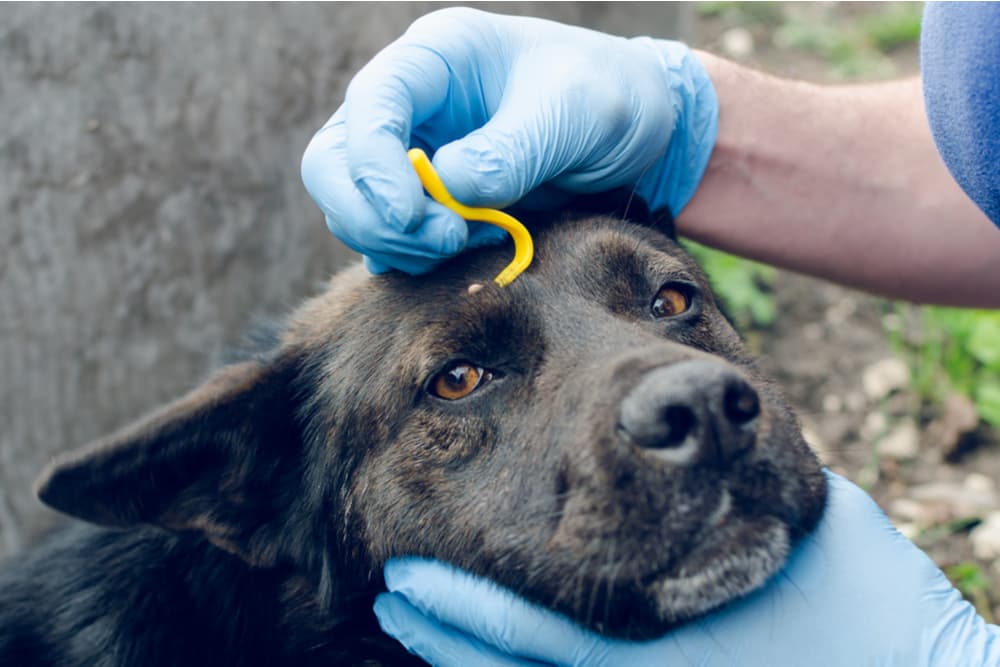5 Tick Removal Tools (and How to Use Them)

Dogs and pet parents alike appreciate when warmer weather finally arrives, but the unfortunate byproducts of the pleasant temps are the creepy crawlies hiding outside.
Bugs range from being a nuisance, like gnats, to being a true health hazard, like ticks. Keeping ticks off your pet with a parasite preventative is your first line of defense, but these persistent creatures can still latch on despite your best efforts.
In order to pull off ticks safely and effectively, pet parents need to have the right kind of tick removal tools. But with so many options available, how do you choose the right one for your dog?
What is a Tick Removal Tool?

Tick removal tools are specifically designed to safely pull a tick’s whole body and head from your pet without putting you or your pet in jeopardy.
While it might be tempting to just grab onto a tick embedded in your dog’s skin and try to yank it out with your fingers, your hands aren’t the best instruments for tick removal. Not only are they ineffective at getting out the entirety of the tick, but you also run the risk of accidentally squeezing the tick and injecting the infectious agents into your dog.
Plus, pet parents with cuts on their hands are at a greater risk of coming in contact with potential harmful tick-borne disease, such as Lyme disease or Rocky Mountain Spotted Fever.
Tick tool designs vary from basic tweezer-type implements to tools that use leverage to remove the tick. The right type of tool for you and your pet depends on a few factors:
- Your dexterity
- Your dog’s fur type
- The location of the tick on your dog’s body
- The size of the tick
Speedy tick removal is critical since these parasites carry a number of diseases that are harmful to pets and people alike. Ticks feed on the blood of mammals by latching on for a day to as long as a week. They can’t fly or jump and require direct contact in order to attach to a host, so they’re most commonly found in tall grass, leaves, and woodland paths where a potential host might brush up against them.
What makes these parasites even more dangerous is that they can be tiny—as small as the size of a pinhead or grain of sand. Ticks also like to hide on dogs in hard to find places, such as under armpits, and in and around ears. The best way to prevent disease transmission is to check your dog for ticks after they play in areas where ticks are known to reside, and if you find a tick, use a dog tick removal tool within 24-hours of a tick attaching.
Common Tick Removal Tools

Though the goal is the same no matter the tool, the design and mechanics of how to use tick tools varies. Below are some common types of tick removal tools, how to use them, and which situations they work best for.
Basic Tweezers
Many households already have tweezers but it’s important to note that the pointed, fine-tipped style is the most effective type for tick removal. Metal tweezers are easy to use on ticks of all sizes and can be sterilized by soaking in rubbing alcohol once the job is complete. However, the sharp ends might pinch your dog, particularly if the tick is small.
Tick Key

Instead of pulling up on the tick, this tool moves across the skin to drag the tick out. It’s simple to use, and because it’s not sharp it doesn’t cause pain to your dog when removing a tick. This metal tool can be sterilized once the tick is removed. However, it might not be effective on smaller ticks, since the tool could pass over a tiny tick’s body. The size of the tool might also make it challenging to use on certain parts of your pet’s body, like close to the eyes or on the tail.
Tick Scoop

This plastic tool is a single motion removal tool that gets rid of ticks via a v-shaped notch in a spoon-like bowl. Once the tick is isolated within the notch it can be removed with a forward sliding motion. These tools have a comfortable, familiar shape, and if the tick is large enough it’s easy to remove. However, it might be difficult to capture smaller ticks within the notch, and because it’s made of plastic it’s not as sturdy and can’t be sterilized as thoroughly as metal tick removal tools.
Tick Twister

As the name suggests, this plastic tick tool is shaped like a tiny garden hoe and requires a twisting motion to remove the parasite. This tool usually comes in two sizes, enabling even the smallest ticks to be isolated and removed. However, while the small size is good for snagging tiny ticks, pet parents with large hands might find it difficult to manipulate. It can also be challenging to use on dogs with long fur, as it might become tangled in the tool during the twisting removal process.
Metal Tick Removal Set

These metal tool sets look like medical-grade equipment and can be easily sterilized after use. The tweezer has a long handle that allows for better leverage, and the fine pointed tip can isolate even the smallest ticks. The notched tool can be used with a forward sliding motion for larger ticks. These tools are heavy, which could make them uncomfortable for smaller dogs, and the sharp, pointed end of the tweezers could be painful if accidentally poked into the skin.
How to Safely Remove a Tick

No matter what type of tool you select for tick removal, the basic procedure for how to pull a tick out remains the same. Keep your dog calm during the process since reactivity will make the job more challenging for both parties. It might help to give your dog a xylitol-free peanut butter-filled toy to keep them occupied, especially if the tick is attached in a difficult location.
Step 1: Part your dog’s fur and place the tool near the embedded base of the tick and close to your dog’s skin.
Step 2: Pull the tick out using steady, even pressure and without wiggling or squeezing the tick. Make sure you’re following the directions for removal based on the type of tool you are using.
Step 3: Place the tick in rubbing alcohol to kill it and use an antibiotic wipe or spray to clean the area around the bite.
Step 4: Don’t forget to wash your hands as well once you’ve finished cleaning your dog.
Monitor your dog for signs of illness after the removal of a tick. Check the site of the bite for redness or swelling, and watch for malaise, reluctance to move or a loss of appetite. Contact your veterinarian if your pet’s health declines.
Other Helpful Items for Tick Removal

While picking the right tool to actually remove the tick from your dog is important, pet parents should also have a few other items on hand during the process.
These items include:
- Rubber gloves for an extra layer of protection
- A magnifying glass for small ticks
- Disinfectant for the tick tool
- A lidded jar to keep the tick for further examination if your dog seems ill
Where to Buy Tick Removal Tools
Most brick and mortar pet stores and online retailers carry a variety of tick removal tools. They range from $5 to $15 dollars, and many come in multi-packs.
Given tick size fluctuations and the variety of places on your dog’s body where these parasites can latch, it’s helpful to purchase a few different types of tools so that you’re prepared for speedy tick removal in every scenario.









